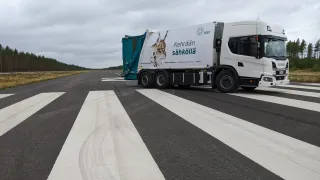The all-electric refuse truck of Helsinki Region Environmental Services HSY has proven that switching the powerline is possible also in waste collection. The experiment results provide valuable information for future development projects and accelerate the electrification of heavy traffic.
The development of an electric refuse truck was launched five years ago as a pilot project in the Smart Otaniemi innovation ecosystem. The pilot aimed not only to test an electric refuse truck in northern weather conditions but also to minimise the overall impacts of waste collection: the reduction of noise and emissions in the collection area has a direct impact on human well-being. For the past six months, the electric refuse truck of HSY, recognisable by its lynx painting, has been in operation in the Helsinki region.
The test phase has shown that the electric chassis is working as expected, and the truck's energy consumption has been surprisingly low. In refuse collection, the truck consumes approximately 2.3 kilowatt-hours of electricity per kilometre, and most of the energy consumption comes from driving (1.4 kWh/km). At its best, the truck was driven for a total of 12 hours in February without interim charging, which consumed roughly 70 percent of the battery. During the day, more than five hundred refuse containers were emptied, and with two unloads, the truck covered over 120 kilometres. The user experiences collected from the drivers show that the truck also meets their needs well. It causes no local emissions, apart from noise pollution, and even for that, the piloted truck outperformed current models.
From airfield tests to city streets
Before the test period, noise measurements were carried out in autumn 2022. At Nummela Airfield, VTT measured the pass-by noise of the electric vehicle and the noise from refuse handling with standardised waste and compared the results with those of a diesel-powered refuse truck. The study was carried out by recording the noise with multichannel, calibrated measuring equipment and by analysing the recordings comprehensively afterwards. If needed, the recordings can also be further analysed later.
Based on the measurements, the electric refuse truck is notably quieter than the traditional diesel-powered model. The electric motor has no effect on noise from refuse handling, but the tests showed that a rubber mat installed at the bottom of the refuse hopper effectively suppresses the clatter caused by hard waste. In addition, experiments confirmed that noise from the hydraulic pump can be effectively reduced with a noise reduction enclosure.
Pilot results will speed up future experiments
The electric refuse truck experiment achieved its goals, albeit with a few bumps in the road. The aim was to assemble a quiet refuse truck, which was achieved. In addition, various noise-reduction measures were tested, and knowledge was acquired on how an electric refuse truck operates in winter conditions.
At the beginning of the project, the availability of electric trucks was limited, which delayed the acquisition of an electric truck chassis. The original objectives also included developing an electric refuse collector. The target was ultimately not met due to regulations: because of the risk of crushing, the refuse collector must be certified, and the components used for it must be classified. As suitable electric actuators are not yet widely used, it is difficult to find components that have been approved for safety critical use. Therefore, the decision was made to use hydraulic cylinders instead of electric actuators.
Despite the delays in the pilot, the future of electric refuse trucks looks bright. Various actors have begun their own experiments with electric refuse trucks, and in the next few years, silent and emission-free refuse collection will be more and more visible in the streetscape. The electric refuse truck assembled in the pilot will continue in operation in Helsinki, and HSY will also rent it for trial use to other waste collection authorities.
The pilot has produced a lot of useful information and guidelines for future research and development. Future projects can focus, for example, on the heating and demisting of the cabin, which currently account for a fairly large proportion of the energy consumption of the truck. There is also still work to be done in developing the charging infrastructure. Using an electric refuse truck efficiently in two shifts or on long collection routes would require fast-charging infrastructure dedicated to commercial electric heavy-duty vehicles.
The world's quietest refuse truck pilot, co-financed by Business Finland, has been implemented by Helsinki Region Environmental Services HSY, VTT, NTM and Motiomax.
HSY bulletin: https://www.hsy.fi/ymparistotieto/tiedotteet/sahkoisen-jateauton-kayttokokeilu-on-antanut-rohkaisevia-tuloksia/ (in Finnish)

